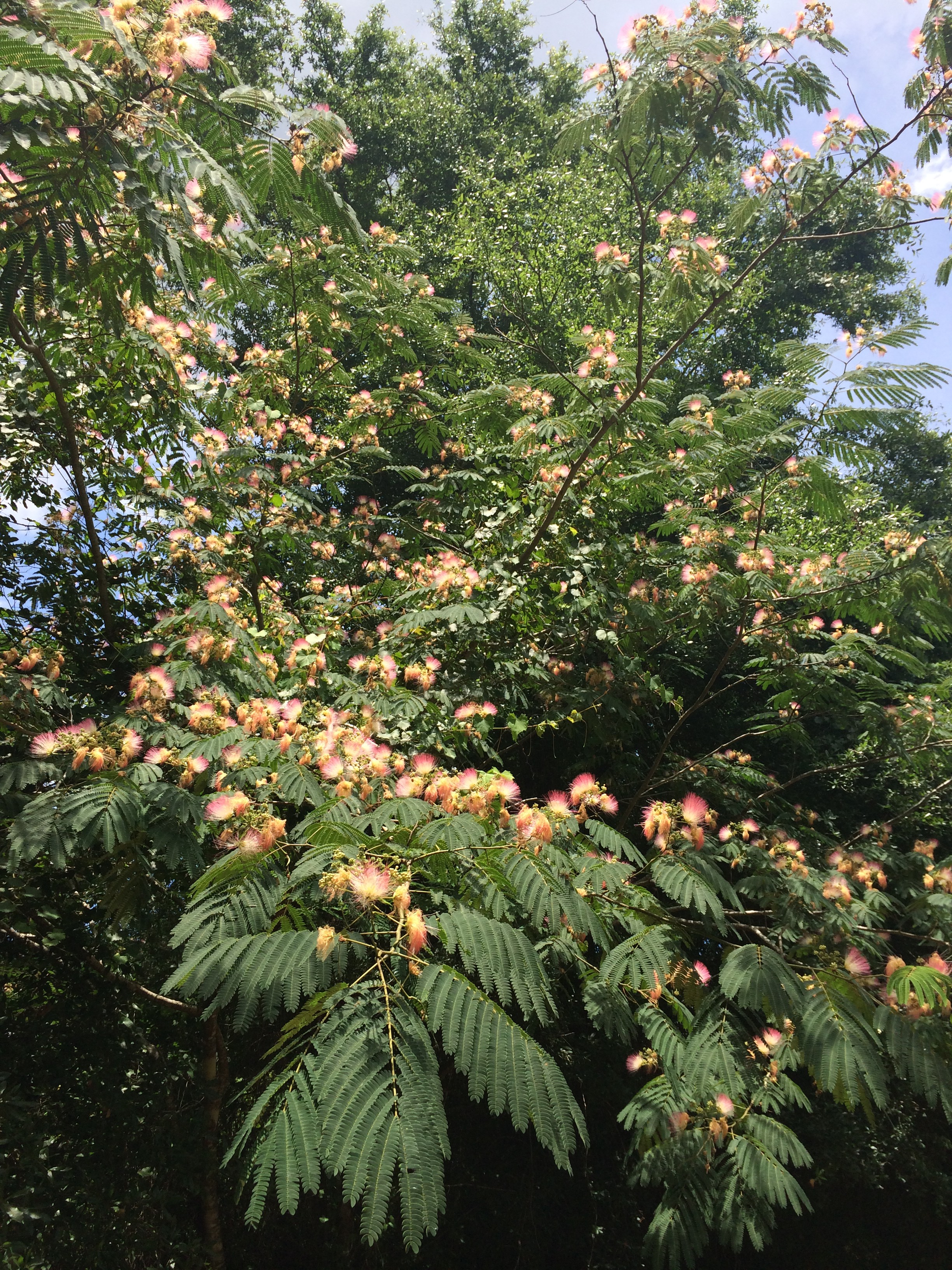
by Mary Salinas | Jun 10, 2014
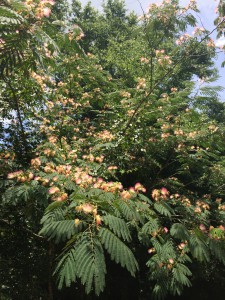
A mimosa tree invader in a natural area. Photo by Mary Derrick, UF IFAS.
All along the roadsides and in home landscapes this time of year, a profusion of fluffy pink blossoms are adorning trees known as Mimosa, or Albizia julibrissin. This native of China was introduced to home landscapes in this country in the 1700’s to enjoy the fragrant, showy flowers and fine, lacy foliage. However, there is a dark side to this lovely tree. After blooming, it produces an abundance of pods each containing 5 to 10 seeds. Seeds can be spread by wildlife and water; this is evidenced by the appearance of mimosa trees along the roadways, streams and in our natural areas. The seeds can also remain dormant for many years, allowing seedlings to keep sprouting up long after the mother tree is gone.
Mimosa has been categorized as an invasive exotic plant in Florida as it has not only naturalized, but is expanding on its own in Florida native plant communities. This expansion means that our native plants in natural areas get crowded out by the mimosa as it reproduces so prolifically.
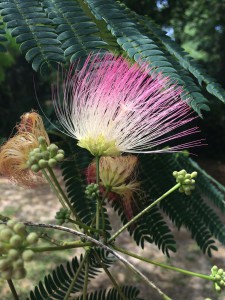
Bloom and foliage of the invasive mimosa tree. Photo by Mary Derrick, UF IFAS.
[important]The Florida Exotic Pest Plant Council (FLEPPC) publishes a list of non-native plants that have been determined to be invasive. Click here for the most recent 2013 list![/important]
The first step in controlling this pest plant is to remove existing plants in the landscape. Cutting it down at soil level and immediately painting the stump with a 25% solution of glyphosate or triclopyr should do the trick. Other details and control methods can be found here.
There are some native trees that make excellent alternatives to Mimosa such as fringe tree (Chionanthus virginicus), silverbell (Halesia carolina) and flowering dogwood (Cornus florida).
For more information:
Albizia julibrissin: Mimosa
UF IFAS Center for Aquatic and Invasive Plants: Mimosa
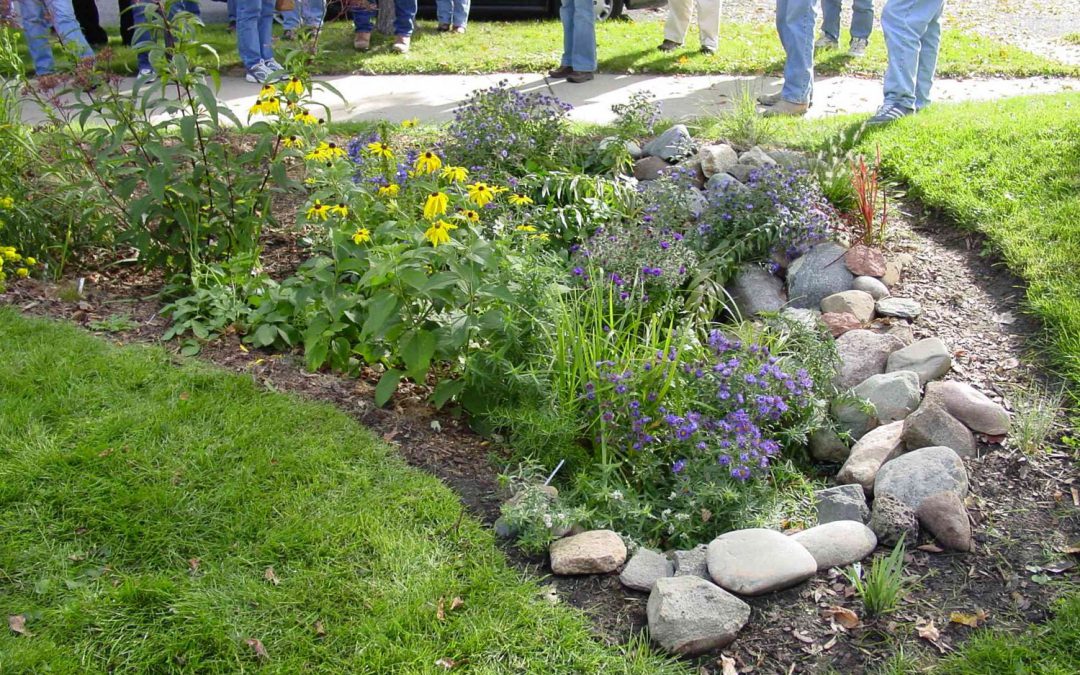
by Carrie Stevenson | May 27, 2014
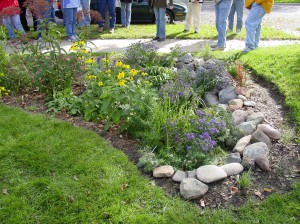
Rain gardens can make a beautiful addition to a home landscape. Photo courtesy UF IFAS
Northwest Florida experienced record-setting floods this spring, and many landscapes, roads, and buildings suffered serious damage due to the sheer force of water moving downhill. That being said, we are just entering our summer “rainy season,” so it may be wise to spend extra time thinking about how you want to landscape based on our typically heavy annual rainfall. For example, if you have an area in your yard where water always runs after a storm (even a mild one) and washes out your property, you may want to consider a rain garden for that spot.
Rain gardens work similarly to swales and stormwater retention ponds in that they are designed to temporarily hold rainwater and allow it to soak into the ground. However, they are quite different aesthetically, because they are planted with water-tolerant trees, shrubs, groundcovers and flowers to provide an attractive alternative to the eroding gully that once inhabited the area! Rain gardens are not “created wetlands,” but landscaped beds that can handle both wet and drier soil. Many of the plants best suited for rain gardens are also attractive to wildlife, adding another element of beauty to the landscape.

This diagram shows how a rain garden works in a home landscape. Photo courtesy NRCS
A perfect spot for a rain garden might be downhill from a rain gutter, areas notorious for excess water and erosion. To build a rain garden, the rainwater leaving a particular part of the property (or rooftop), is directed into a gently sloping, 4”-8” deep depression in the ground, the back and sides of which are supported by a berm of earth. The rain garden serves as a catch basin for the water and is usually shaped like a semi-circle. The width of the rain garden depends on the slope and particular site conditions in each yard. Within the area, native plants are placed into loose, sandy soil and mulched. Care should be taken to prevent the garden from having a very deep end where water pools, rather allowing water to spread evenly throughout the basin.
Besides reducing a problematic area of the lawn, a rain garden can play an important role in improving water quality. With increasing populations come more pavement, roads, and rooftops, which do almost nothing to absorb or treat stormwater, contributing to the problem. Vegetation and soil do a much better job at handling that water. Excess sediment, which can fill in streams and bays, and chemicals from fertilizers and pesticides are just some of the pollutants treated within a rain garden via the natural growth processes of the plants. Many commercial properties are considering rain gardens, also known as “bioretention” as more attractive alternatives to stormwater retention ponds.
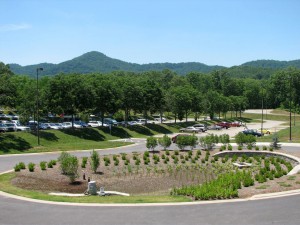
The North Carolina Arboretum used a planted bioretention area to manage stormwater in their parking lot. Photo courtesy Carrie Stevenson
A handful of well-known perennial plants that work great in rain gardens include: Louisiana iris, cinnamon fern, buttonbush, Virginia willow, black-eyed Susan, swamp lily, tulip poplar, oakleaf hydrangea, wax myrtle, Florida azalea, river birch, holly, and Southern magnolia. For a complete list of rain garden plants appropriate for our area, visit the “Rain Garden” section of Tallahassee’s “Think about Personal Pollution” website, tappwater.org or contact your local Extension Office.
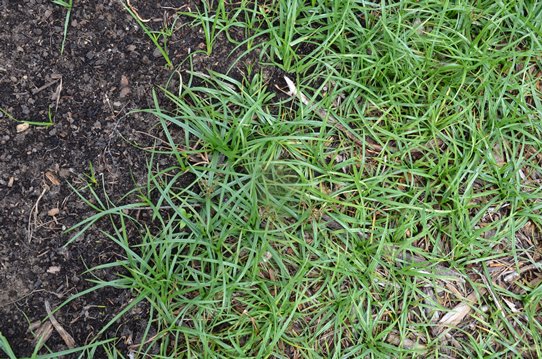
by Les Harrison | May 6, 2014

Purple Nut Sedge aggressively moves into any sunny open space and crowds out competitors.
The spring season in panhandle Florida is colorful. Every location from frequently manicured gardens to untended fields and pastures are exploding with hues and tones pleasing to the eye.
These heralds of the warmer weather to come are trailed by the warm season’s greenery which fills in the gaps between blooms. The consistent and ample rains have assured the continuance of a bright and pleasing landscape backed by countless shades and textures of green.
The adequate moisture has also assured the aggressive growth of an individually small, but collectively gigantic, weed which plagues every member of humanity associated with attempting to cultivate plants.
Purple nut sedge, Cyprus rotundus, has emerged en mass from every possible sunny location with soil. This native plant is a rapidly spreading perennial which will take every opportunity to colonize new locations.
The identifier purple is in the name because there is a purple-tinged section of this sedge where it emerges from the ground. The plant is sometimes referred to as purple nut grass because of its long narrow leaves and its erect growth pattern originate from a nutlike basal bulb.
There are other sedges in north Florida, but only yellow nut sedge is identified by a specific color. It is sometimes called chufa and is a popular feed for wild turkeys and turkey hunters.
The dark green, smooth leaves blend in easily with many turf grasses. Beneath the soil’s surface and out of sight, the root system grows in every direction.
Purple nut sedge’s roots are a series of spreading rhizomes and tubers or bulbs identified as nutlets. Each nutlet sprouts a new bunch of grass-like leaves and continues growing the rhizomes.
The densely population of this sedge quickly crowds out most other plants, but most especially turf and forage grasses. It can reach a height of 18 inches on its triangle shaped stem.
The root system’s design assures this plants survival and continued success. If pulled, the rhizomes break off leaving a large number of nutlets to develop and emerge at a later date.
If plowed or tilled, the nutlets are detached and spread to new and inviting locations. Many times nutlets lodge in tillage equipment only to shake loose and deposited in un-colonized locations.
Most herbicides have little on this sedge’s hardy root system. Selected pre-emergent herbicides will prevent many of the nutlets from germinating in spring.
North Florida’s sandier soils provide an ideal growing environment for purple nut sedge. The occasional periods of water saturation from storms do not deter this plant’s rapid and growth expansion to new areas, but it will not tolerate heavy shade.
Purple nut sedge’s extreme competitive nature is a heavy consumer of plant nutrients and robs rivals of important compounds necessary for their survival. Additionally, it produces an allelopathic substance which is toxic to some plants.
Purple nut sedge is found in many locales in North America where the environment is hospitable to its growth. The lush green leaves and touch of purple signify work for anyone who is maintaining a lawn or garden.
To learn more about purple nut sedge in north Florida contact your local UF/IFAS County Extension Office and read this informative publication on purple nutsedge.

by Alex Bolques | Mar 25, 2014
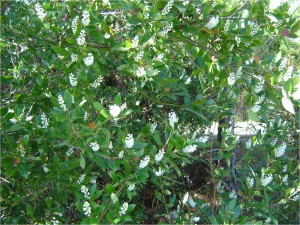
Black Titi in bloom. Flower clusters upright at tips of branches. An excellent source of nectar and pollen for honey production. Image: Alex Bolques
Black Titi (also known as Spring Titi or Buckwheat Tree (Cliftonia monophylla (Lam.) Britton ex Sarg. is a native shrub or tree that can be found growing along streams and boggy areas of the Florida Panhandle. It can tolerate acidic wetland soils and once established can also tolerate dry soils in the landscape. Black Titi can reach 15 – 30 feet in height with 3 – 4 inches of trunk diameter. Its bloom period lasts February through March.

Bee visits a Black Titi flower. Image credit: Alex Bolques
Beekeepers love it because it is a wonderful source of nectar and pollen for honey production. Beginning beekeepers may confuse Black Titi with White Titi (also known as Summer Titi or Swamp Titi (Cyrilla racemiflora L.). It should not be grown as a honeybee pollinator plant. The nectar and/or pollen of White Titi can promote a condition known as “Purple brood”, which can be detrimental to honeybee immature stages.The flower of the spring flowering Black Titi is a raceme, a cluster of flowers along a central stem, that appears as an upright cluster on the tip of branches. The flower of the summer flowering White Titi is also a raceme, not as upright, more elongated. Visit the USDA Natural Resource Conservation Service plant database website and click on the image tab to see Black Titi (Buckwheat Tree) or White Titi (Swamp Titi) to view differences in flower morphology.

by Carrie Stevenson | Mar 18, 2014
The first week of March every year is designated “National Invasive Species Awareness Week,” an initiative to draw attention to the thousands of invasive plants and animals that move into our state and country every year. However, this is a problem that should draw focus year-round.
Invasive species are non-native or exotic plants and animals which can cause harm to the local economy, human health, and the environment. They often out-compete native species, causing habitat degradation, wildlife community imbalances, and diseases that can destroy economically important plants. This is a worldwide issue that can be addressed on local levels. In Florida, researchers have documented over 1,180 exotic plant species and more than 500 non-native fish.
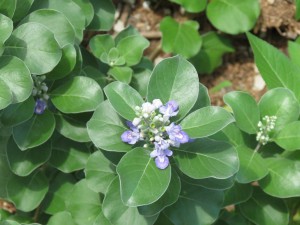
Beach vitex is a newly introduced invasive found on our local barrier island due systems. Photo credit: Rick O’Connor
Prevention is among the most effective ways to manage invasive species. Gardeners should be aware of invasive species and make sure they are not unintentionally passing them on to neighbors or natural areas. While many non-native plant species perform well in our yards and do not become invasive, pay close attention to new plants that start taking over your yard. If you’re unsure of the status of a plant, call your local Extension Office or check the Florida invasive plant list.
When enjoying outdoor activities such as camping, hiking, or biking, be sure to inspect what might have attached to your clothing to prevent further seed dispersion.
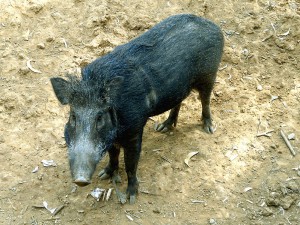
Wild hogs cause significant damage to ecosystems throughout Florida.
Released pets are a nearly impossible problem to manage, as well. If you have a pet that you can no longer keep, please find an alternative home for it. Releasing pets into the wild can have serious implications for native wildlife and cause harm to your animal. One needs look no further than the python problem in the Florida Everglades to see the extent of damage this unwise practice can cause. Great information on what to do with unwanted pets can be found at Habitattitude.
Among the most important invasive plants to be aware of in our area include: cogongrass, Chinese tallow (popcorn trees), coral ardisia, water hyacinth, Japanese climbing fern, Chinese privet, tropical soda apple, torpedo grass, and beach vitex. Among invasive animal species in the area, be on the lookout for: lionfish, crazy ants, feral hogs, and Cuban treefrogs.
There are many ways to get involved in the battle against invasive species, including joining your local Cooperative Invasive Species Management Area (CISMA) group. Special thanks to Brooke Saari (bsaari@ufl.edu) for contributing to this article.
by Blake Thaxton | Mar 12, 2014
Oakleaf Hydrangeas (Hydrangea quercifolia) make a beautiful choice for the home landscape. They present great interest in all seasons of the year. Not only do they produce beautiful blooms in summer, but the plant also provides great fall color. When making a choice for a new edition to your landscape, select Oakleaf Hydrangea !

Jeff McMillian @ USDA-NRCS PLANTS Database
Oakleaf Hydrangea is native to Southeastern United States. I have personally observed hundred of Oakleaf Hydrangeas along streams and on the mountains at the Talledega National Forest in Alabama. When I saw them they were dormant, as it was February, but it would be a magnificent site when they are all in bloom.

Jeff McMillian @ USDA-NRCS PLANTS Database
Oakleaf Hydrangea blooms are magnificent panicles that change throughout the season. First creamy white color, turning to a pink and finally desiccating to brown. There is something attractive about the brown dried bloom and it holds on for quite some time. In winter, the exfoliating bark make it attractive even though it is without leaves. This trait, along with the dried out bloom, make it enjoyable throughout the entire year.
















